
About Canoe Slalom
Canoe Slalom is a water sport that requires not only strength but also a high amount of skill and balance from the player. This sport is like white-water rafting where player navigate through the strong water currents both upstream and downstream using a canoe or kayak.
The player who completes the course in the fastest time is declared as the winner. The race is conducted in heats and finals. Each participating player gets two runs in the heat and the fastest time recorded by the player is considered as the time clocked by the player.
In the competition, the watercourse is constructed artificially and are usually 250m to 400m long with water gushing through the course at high speeds. The difficulty level varies from class-2 to class-4 white water level. The watercourse contains natural or artificial obstacles to test the skill of the player.
The watercourse obstacles are placed in such a way to produce currents, eddy and rocks obstacles. The player must negotiate gates suspended from the air from a wire.
There are two types of gates those marked as green are downstream gates, and those marked red are upstream gates. A minimum of 25 gates that the player must negotiate out of which minimum of 6 gates is upstream.
International Canoe Federation (ICF) is the governing body of the Canoeing. They organize the sports; formulate the rules, and the design specifications of the boats and other equipment.
Canoe Slalom Olympic 2020 logo : ![]()
History
Boating through the rushing water was a popular adrenalin sport. White water rafting gained in popularity with the increase in the number of participants.
A natural course of water with different obstacles was selected to stage this sport. With the gain in popularity, this sport was divided based on the type of boats and technique used.
Canoe Slalom made its first competitive appearance in 1940 in Europe. International Canoe Federation (ICF) was established as the governing body for the sports. The first world championship was held in 1949 in Switzerland. This sport was introduced as an Olympic sport in Barcelona Olympics in 1992.
Objective
The objective of a Canoe Slalom player is to negotiate the defined watercourse defined by gates, without touching the gates or missing them, in the shortest possible time. Each fault leads to penalty time added to the player.
Compared to wild water rapids, where natural conditions affect the outcome, the artificial course provides a consistent water flow, with subtle current changes.
The idea is to read the current and understand the course to choose the easiest path from one gate to the other, trying to ride the current to move efficiently down the course.
Negotiating the upstream gate, the competitor must have the skill to reduce their speed by finding a slow current to thrust the paddle into and changing the direction of the boat. The boat can also be manoeuvred backwards around the gate. Each competitor has a different strategy to navigate the course.
Events
In the Olympics, there are four medals associated with this sport. This sport has two categories Canoeing (C) and Kayaking (K)
- C1 (canoe single) Men
- C2 (canoe double) Men
- K1 (kayak single) Men
- K1 (kayak single) Women
In 2020, the event of C2 (canoe double) men will be dropped and instead, C1 (canoe single) Women would be introduced. Thus starting 2020, the new events for the Olympics for this sport are:
- C1 (canoe single) Men
- C1 (canoe single) Women
- K1 (kayak single) Men
- K1 (kayak single) Women
Boats
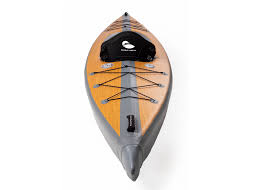
Canoe is a decked boat that are paddled by single blade paddle. Players must be kneeling inside the canoe for driving it.
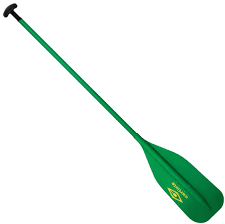
Kayak is a decked boat that are paddled by a double-bladed paddle. Players must be sitting inside the kayak for driving it.
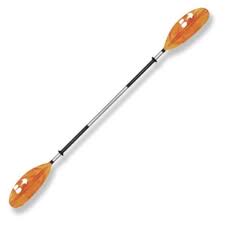 Both Canoe and Kayak should have a minimum weight of 9 kilos, with the dimension of 3.50m and width of 0.60m. All the boats must have a minimum radius at each end of 2 cm horizontally and 1 cm vertically.
Both Canoe and Kayak should have a minimum weight of 9 kilos, with the dimension of 3.50m and width of 0.60m. All the boats must have a minimum radius at each end of 2 cm horizontally and 1 cm vertically.
Boats should not have a rudder. Any object protruding from the hull must be manufactured into the hull mould and be no higher than 20mm and no narrower than 8mm with a minimum radius of 4mm on its outside edge.
Safety - Boats and Player
Boats
The boats should be made up, of unsinkable material, they must be equipped, with a handle attached at each end and that should be no more than 30 cm from the bow and the stern.
The handles must be present in the boat and should be an integral part of the manufactured boat, to permit easy insertion of an entire hand up to the base of the thumb to hold the boat.
The tapping of handles is not permitted. The material used for the manufacture of the boat should be a minimum of 6mm in diameter with a minimum cross-section of 2 X 10 mm.
Players
All players are required to wear helmets fastened with a strap to their chin. The helmets should be of strong material. Players are also required to wear buoyancy jacket. The jacket’s uplift should be about 6.12 Kg.
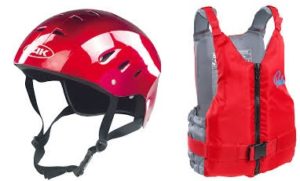
Race Officials
The following race officials keep a strict eye on the performance of the participants.
Chief Judge: The chief judge is the final adjudicator for all judging matters. Official video of each run is recorded, and the chief judge may check the video footage in case of any disputes to determine the verdict. After the decision of the chief judge is made, it cannot be protested or contested.
Asst. Chief Judge: They closely assist the chief judge and the course coordinator.
Gate Judge: The responsibility of the gate judge is observing the player passage through the gates.
Start Judge: The start judge permits a player to start. The judge may refuse to give the start permission, in case the player is not in proper gear or violates safety rules.
Finish Judge: The Finish Judge determines when an athlete has finished the course in the properly.
Time Keeper: They are responsible for keeping the exact time the player takes to complete the course.
Chief of Scoring: They are responsible for accurate calculation of scoring and penalty time for a player.
Race Course
Course: The racecourses can be natural or man-made. They are specifically designed, to test all the technical skills of the player. The courses are also technical and classified between Class II to Class IV depending upon the level of difficulty.
The racecourse is 200m to 400m with water gushing at high speed. The course is designed to have 25 gates with a maximum of 6 gates are upstream gates. The player has to cross the downstream gates along with the flow of the water. The player has to cross the upstream gates against the flow of the water.
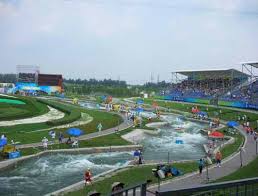
Gates: The gates consist of two hanged poles, painted with green and white for identifying the downstream gates and red and white for identifying the upstream gates. Each gate displays the gate number. The width between the gates poles is about 4m. The gate poles should be about 20cm above the surface of the water and should not be disturbed by the movement of water.
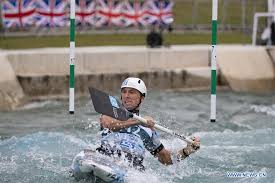
Scoring
Two seconds is added to their completion time in case a player touches the pole, and 50 seconds is added to their completion time in case a player misses any gate.
The fastest player to complete the course with minimum faults and time deductions is declared as the winner. The completion time varies based on the complexity of the course. The formulae used to calculate the best time is
Best time run in seconds + penalty seconds = Result
Rules Of Canoe Slalom
- The player should not touch any poles during their run. Touching a pole adds a two seconds penalty to their completion time.
- The player should not miss any pole. Missing any pole adds a 50 seconds penalty to their completion time.
- The player should cross the finish line in an upright position and not with their boat capsized.
- The finishing line must be downstream and so should be the last gate.
- There are no false starts in Canoe or Kayak, the timing starts as the player crosses the starting gate.
- The gates should be moved through by the player in the right order as mentioned by their numbers.
- In case the boat capsizes, and the player can regain the upright position then no points are deducted. However, if the boat capsizes and the player leaves the boat, the player is disqualified.
- Each player gets two runs through the course and the fastest time of the player is taken, as their completion time.
- If two players are tied, after both the runs, then they both proceed further to semi-finals. In case two players’ timings are tied in the finals then they share the place and the rankings.
- The head of the player should go through the gates for it to count.
World Rankings
- Canoeing – Men (C1)
- Matej Beňuš

- Luka Božič

- Michal Martikán

- Canoeing – Women (C1)
- Jessica Fox

- Ana Sátila

- Tereza Fišerová

- Kayaking – Men (K1)
- Jiří Prskavec

- Peter Kauzer

- Vít Přindiš

- Kayaking – Women (K1)
- Jessica Fox

- Eva Terčelj

- Corinna Kuhnle





 (2 votes, average: 5.00 out of 5)
(2 votes, average: 5.00 out of 5)


